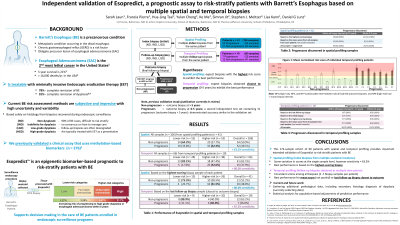Monday Poster Session
Category: Esophagus
P1814 - Independent Validation of Esopredict, A Prognostic Assay to Risk-Stratify Patients With Barrett’s Esophagus Across Multiple Spatial and Temporal Biopsies
Monday, October 23, 2023
10:30 AM - 4:15 PM PT
Location: Exhibit Hall

Has Audio

Sarah E. Laun, PhD
Previse
Baltimore, MD
Presenting Author(s)
Sarah E.. Laun, PhD1, Francia Pierre, MPH1, Hua-Ling Tsai, MS2, Yulan Cheng, MD3, Ke Ma, MD4, Simran Jit, MD3, Stephen Meltzer, MD3, Lisa Kann, PhD1, Dan Lunz, MBA1
1Previse, Baltimore, MD; 2Johns Hopkins University School of Medicine, Baltimore, MD; 3Johns Hopkins University, Baltimore, MD; 4Einstein Medical Center, Philadelphia, PA
Introduction: Esopredict is a validated biomarker assay providing a straightforward, accurate, quantitative risk assessment in patients with Barrett’s esophagus (BE). This epigenetic test stratifies future neoplastic risk into four categories: low, favorable intermediate, unfavorable intermediate, or high. The current study was performed to establish further independent validation of Esopredict.
Methods: We profiled 149 samples of 51 BE patients with multiple biopsies from either the same endoscopy (“spatial” profiling) or other follow-up endoscopies (“temporal” profiling). All had initial histologic diagnoses of nondysplastic (ND), indefinite for dysplasia (IND), or low-grade dysplasia (LGD). All final follow-up biopsies were either high-grade dysplasia (HGD) or EAC (progressors), ND, IND, or LGD (non-progressors). Based on an algorithm consisting of 4 epigenetic biomarkers plus age, a normalized risk score and risk category were determined for each biopsy sample.
Results: Among 41 patients comprising 105 spatially profiled samples, 21 were non-progressors, and 20 were progressors. Based on each patient’s highest risk score, Esopredict had a sensitivity of 100% and specificity of 67%, with 0 true progressors classified as low-risk. Among 14 patients comprising 54 temporally profiled samples, 7 were non-progressors, and 7 were progressors. Based on each patient’s biopsy obtained an average of 5 years (2.5-7.6) before the outcome biopsy, 6 of 7 non-progressors were classified as low or favorable intermediate, while 5 of 7 progressors were unfavorable intermediate or high. Among 31 biopsies from progressor patients, 71% were classified as unfavorable intermediate or high, with 90% classified as greater than low-risk.
Discussion: This 149-sample cohort of 51 patients with spatial and temporal profiling provides important extended validation of this biomarker assay. The ability to risk-stratify BE patients may improve management by identifying high-risk patients who may benefit from increased surveillance and/or endoscopic treatment while also finding low-risk patients for less frequent surveillance and/or less endoscopic intervention.
Disclosures:
Sarah E.. Laun, PhD1, Francia Pierre, MPH1, Hua-Ling Tsai, MS2, Yulan Cheng, MD3, Ke Ma, MD4, Simran Jit, MD3, Stephen Meltzer, MD3, Lisa Kann, PhD1, Dan Lunz, MBA1. P1814 - Independent Validation of Esopredict, A Prognostic Assay to Risk-Stratify Patients With Barrett’s Esophagus Across Multiple Spatial and Temporal Biopsies, ACG 2023 Annual Scientific Meeting Abstracts. Vancouver, BC, Canada: American College of Gastroenterology.
1Previse, Baltimore, MD; 2Johns Hopkins University School of Medicine, Baltimore, MD; 3Johns Hopkins University, Baltimore, MD; 4Einstein Medical Center, Philadelphia, PA
Introduction: Esopredict is a validated biomarker assay providing a straightforward, accurate, quantitative risk assessment in patients with Barrett’s esophagus (BE). This epigenetic test stratifies future neoplastic risk into four categories: low, favorable intermediate, unfavorable intermediate, or high. The current study was performed to establish further independent validation of Esopredict.
Methods: We profiled 149 samples of 51 BE patients with multiple biopsies from either the same endoscopy (“spatial” profiling) or other follow-up endoscopies (“temporal” profiling). All had initial histologic diagnoses of nondysplastic (ND), indefinite for dysplasia (IND), or low-grade dysplasia (LGD). All final follow-up biopsies were either high-grade dysplasia (HGD) or EAC (progressors), ND, IND, or LGD (non-progressors). Based on an algorithm consisting of 4 epigenetic biomarkers plus age, a normalized risk score and risk category were determined for each biopsy sample.
Results: Among 41 patients comprising 105 spatially profiled samples, 21 were non-progressors, and 20 were progressors. Based on each patient’s highest risk score, Esopredict had a sensitivity of 100% and specificity of 67%, with 0 true progressors classified as low-risk. Among 14 patients comprising 54 temporally profiled samples, 7 were non-progressors, and 7 were progressors. Based on each patient’s biopsy obtained an average of 5 years (2.5-7.6) before the outcome biopsy, 6 of 7 non-progressors were classified as low or favorable intermediate, while 5 of 7 progressors were unfavorable intermediate or high. Among 31 biopsies from progressor patients, 71% were classified as unfavorable intermediate or high, with 90% classified as greater than low-risk.
Discussion: This 149-sample cohort of 51 patients with spatial and temporal profiling provides important extended validation of this biomarker assay. The ability to risk-stratify BE patients may improve management by identifying high-risk patients who may benefit from increased surveillance and/or endoscopic treatment while also finding low-risk patients for less frequent surveillance and/or less endoscopic intervention.
Disclosures:
Sarah Laun: Previse – Employee, Stock Options.
Francia Pierre: Previse – Employee, Stock Options.
Hua-Ling Tsai indicated no relevant financial relationships.
Yulan Cheng indicated no relevant financial relationships.
Ke Ma: Previse – Stock Options.
Simran Jit indicated no relevant financial relationships.
Stephen Meltzer: Previse – Advisory Committee/Board Member, Intellectual Property/Patents, Stock Options.
Lisa Kann: Capsulomics dba Previse – Consultant.
Dan Lunz: Previse – Advisory Committee/Board Member, Employee, Intellectual Property/Patents, Stock Options.
Sarah E.. Laun, PhD1, Francia Pierre, MPH1, Hua-Ling Tsai, MS2, Yulan Cheng, MD3, Ke Ma, MD4, Simran Jit, MD3, Stephen Meltzer, MD3, Lisa Kann, PhD1, Dan Lunz, MBA1. P1814 - Independent Validation of Esopredict, A Prognostic Assay to Risk-Stratify Patients With Barrett’s Esophagus Across Multiple Spatial and Temporal Biopsies, ACG 2023 Annual Scientific Meeting Abstracts. Vancouver, BC, Canada: American College of Gastroenterology.
